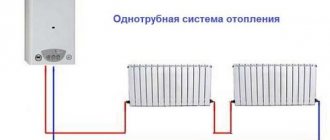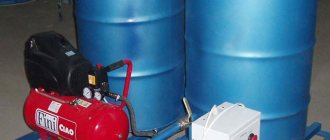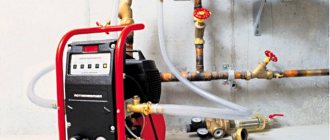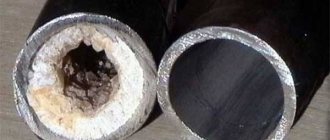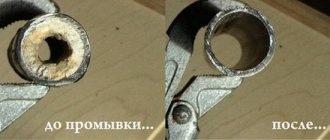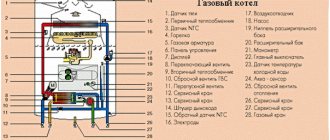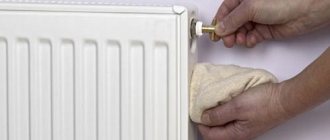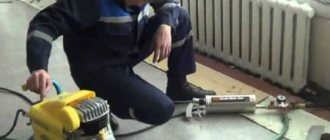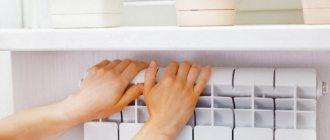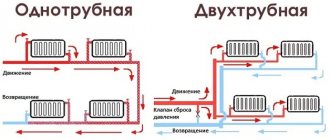Flushing a heating system is the removal of internal contaminants from pipes, radiators, fittings, and boiler equipment.
- Why flush your heating system?
- When should you flush your heating system?
- Methods for flushing the heating system
- Flushing the heating system in an apartment building
- Flushing the heating system in a private house
- Cost of flushing a heating system
- Heating system flushing act
- Flushing the heating system yourself
Why flush your heating system?
Why flush your heating system?
- to reduce heating costs,
- to improve the efficiency of the heating system,
- to increase the service life of heating equipment,
- to reduce the risk of emergency situations.
- In the heating system, salt, silt and sand are deposited on the walls of pipes, radiators, shut-off valves, boilers, and heat exchangers.
The coolant liquid (hot heating water) brings all this to the heating systems.
Year after year, the layer of deposits becomes thicker, and every millimeter of dirt reduces heating efficiency by 10-15%.
Deposits on the walls harden and are then more difficult and expensive to remove.
As a result, heating costs rise and the temperature in the building is below the required minimum.
In a neglected situation, scale deposits in the heating system lead to accidents and failures.
This is what it looks like:
Step-by-step instructions for an independent procedure for cleaning the coolant
It is possible to clean the artificial heating system of a building without a third party. To do this, you will need a pneumatic diaphragm pump capable of raising pressure above 6 atmospheres. Before starting the operation, you need to turn off all the valves and unscrew the radiator end caps with a wrench.
Algorithm:
- Close the resource drain valve.
- Connect the diaphragm pump to the valve located after the shut-off valve.
- Dispose of waste coolant.
- Turn on the membrane pump, raise the pressure to 6 at.
- Open the system valve.
- Turn off all house heating risers one by one. No more than 10 residential highways should be closed per run.
After the operation, you need to connect the pump through the return line to the carrier inlet into the building. However, before this it is necessary to drain the heating. After high-quality treatment of the circuit, the water should come out clear.
When should you flush your heating system?
The heating system must be flushed before the start of the heating season.
This is routine maintenance to keep your heating system in good working order.
Regular flushing of the heating system allows you to use inexpensive cleaning methods.
Bulk and old deposits will have to be removed using specialized washing equipment.
Scheduled flushing of the system increases the trouble-free service life of the heating system several times.
After installation, major repairs, as well as routine repairs with replacement of pipes, it is also necessary to test and flush the heating system.
The timing and methods of carrying out mandatory flushing of heating systems are defined in the following documents:
- “Rules for assessing readiness for the heating season” (approved by Order of the Ministry of Energy of Russia dated March 12, 2013 N 103);
- “Rules and norms for the technical operation of the housing stock” (approved by Resolution of the State Construction Committee of Russia dated September 27, 2003 N 170);
- “Rules and norms for the technical operation of the housing stock” (approved by Resolution of the State Construction Committee of Russia dated September 27, 2003 N 170);
- “Rules for the technical operation of thermal power plants” (approved by order of the Ministry of Energy of the Russian Federation dated March 24, 2003 N 115)
Inspecting radiators using a thermal imager
Unscheduled flushing of the heating system must be carried out:
- when heating efficiency decreases (hot coolant is supplied to the input, and the batteries are cold);
- in case of uneven heating of the radiators (in this case, it is necessary to exclude the presence of an air lock in the radiators);
- reduction in system capacity due to contamination.
To determine accurately, you need to do an inspection of the heating system.
The easiest and fastest way to inspect the heating system and radiators is with a thermal imager.
The examination will determine the thickness and chemical composition of the deposits.
After this, we select the appropriate washing method.
Now we’ll talk about ways to flush the heating system.
Causes of pollution
The main reason is the formation of various debris in the pipeline and directly in the batteries. As a result, the radiators do not work properly and the house does not warm up well.
Often the signal to carry out work is that most of the radiators do not heat well. This is due to several reasons:
- the radiators are filled with air, and it is necessary to bleed air through the Mayevsky taps;
- the system is clogged with dirt.
Determine this so as not to do unnecessary work.
Attention! If the system has been operating for a very long time and consists of a conventional metal pipeline and cast iron batteries, then this prevention is very useful, although there have been cases where even after 10 years of operation, the pipes were not clogged with debris.
There are many reasons for pipe contamination, but they all lead to a decrease in throughput. Source strojdvor.ru
Water hammer method of flushing the heating system
the hydraulic shock (or hydromechanical) method for flushing heating systems of short length (private house, small apartment building).
For minor stains, this method can also be used for large buildings.
For the water hammer method, we connect a pump, which not only ensures circulation in the system, but creates a series of water shocks of the coolant.
Water hammer method of flushing the heating system
Under the influence of water hammer, deposits on internal surfaces are destroyed and then washed away by the flow of water into the sewer.
Water absorbs impact energy well, so the load on the walls of pipes, fittings and radiators is small.
If your heating system is in good working order, there is little risk of damage or leaks.
For preventive cleaning of the heating system, this method is sufficient.
To remove more complex contaminants, other washing methods are used.
Now we will tell you about them.
Tips and tricks
When purchasing heating radiators, it should be taken into account that bimetallic and aluminum heat exchangers have a small volume in which the circulating coolant does not form sediment.
When choosing a heating system, preference should be given to closed types. Such systems are characterized by a constant volume of coolant, which does not allow new deposits to form.
It is best to make the connection at the bottom of the radiator. Since sediment forms in horizontal areas, such a connection helps remove the bulk of the deposits with the flow of the working medium.
It is recommended to install a filter, which does not require large investments, but greatly simplifies the cleaning process. Removing scale from a dirt filter is easier than flushing the riser.
Hydropneumatic method for flushing a heating system
The hydropneumatic method is the main method for flushing heating systems of apartment buildings and large buildings.
For such flushing, we will install a pump with a compressor that will circulate the coolant and supply the required amount of air to the system.
The air-water mixture bubbles in the heating system and actively destroys stubborn deposits.
Hydropneumatic method for flushing a heating system
All contaminants are also washed out of the system by the flow of water.
This method of flushing the heating system is suitable for removing contaminants even from old cast iron radiators.
The cavitation flow of water lifts contaminants even from hard-to-reach areas of the system.
The hydropneumatic method puts less stress on pipes and fittings, but requires the connection of expensive flushing equipment.
There is another way - chemical.
With the chemical method, everything is more complicated, but let's take it in order.
Non-standard methods
Elevator without nozzle
How and with what to flush the heating system of an apartment building in the absence of a compressor and a control campaign? Unfortunately, this also happens far from large cities.
In this case, running the elevator unit without a nozzle for two to three days often helps. When the inlet, house and domestic hot water valves are turned off, the water-jet elevator is removed, the nozzle is removed from it, and the suction (the bottom flange of the elevator) is muffled with a steel pancake.
The water jet elevator has been removed and the suction has been turned off. Water from the supply line of the heating main goes directly into the heating outlet.
As a result:
- of the coolant in the heating circuit increases
- Circulation accelerates . The nozzle no longer restricts the flow of water from the supply thread of the heating main. The difference between the beginning and end of the circuit is not the standard 0.2 kgf/cm2, but 2-3 atmospheres.
Pressure distribution in the elevator unit. It is explained by the operating principle of the water jet elevator (right).
Why is this procedure abnormal? Because in this mode:
- Heat consumption increases many times (that is, its supplier incurs losses);
- The temperature regime of the heating main operation is disrupted. Excessively hot water enters the return line. Due to the technological cycle of the CHP plant, before a new circulation cycle, it has to be cooled to the required temperature.
Flushing tap
How to rinse the battery yourself if the efficiency of the heating device has noticeably dropped over several years of operation?
To begin with, in the summer, before the start of the heating season, it needs to be equipped with a flushing tap.
The blind plug of any modern radiator can easily be converted into a pass-through plug, ready for installation of a flusher. Just unscrew the plug.
The best flusher is a ball valve with male-female threads (external and internal), screwed into the radiator cap.
Inexpensive and reliable washer.
After starting the heating, a regular garden hose is connected to the flushing tap, clamped with a clamp on a pipe with a short 1/2-inch thread. The hose is directed into the sewer - into the toilet or into the bathtub outlet. As soon as you open the tap, the sludge accumulated in the outer sections will fly out at the front of the water flow.
A few nuances:
- Earthenware is afraid of temperature changes . Therefore, it is better to insert the hose into the toilet as deep as possible, so that hot water flows directly into the riser;
If the toilet bowl, into which hot water is discharged during flushing, heats up quickly, it may crack.
- Secure the hose . Otherwise, you risk conducting an unplanned experiment illustrating jet propulsion. Considering that the role of the jet stream will be played by hot and very dirty water, the result will not please you;
- Wait for the water to clear . While dirt is being discharged, continue flushing.
Why did I classify this washing method as non-standard? You see, the operating rules for closed heating systems prohibit the withdrawal of water from the heating system. In open systems, a reset is in principle possible, but in our case it goes past the water meter and again leads to the consumption of unpaid hot water.
All consumed water must pass through metering devices.
Flushing is only necessary for radiators with lateral or diagonal connections. The more sections there are, the faster the last of them become clogged with dirt. With a two-way bottom connection, continuous circulation through the bottom corrector of the device prevents it from silting.
Lateral one-way connection of 10 sections is a guaranteed deposit of silt.
Two-way bottom connection. The lower collector is constantly flushed with coolant.
Chemical method of flushing the heating system
For this method we need special chemistry (acid, alkali).
We add the reagents to the coolant and connect the circulation pump.
The liquid passes repeatedly throughout the system, the chemistry dissolves contaminants.
It is necessary to select the chemical composition of the reagents in accordance with the type of contaminants, material of pipes and heating radiators.
You also need to accurately calculate the flushing time so as not to damage the inner surface of the heating system.
Chemical method of flushing the heating system
The difficulty of the chemical method is that after treatment it is impossible to drain the coolant with washed dirt and chemicals into the sewer.
Aggressive chemicals must be disposed of in a special way.
After chemical treatment, the system is thoroughly washed with running water - the chemical must be removed from the system.
After flushing, we will check the system for leaks - we will test it with pressure.
There is always a possibility of failure of heating system elements (areas with severe corrosion).
Depending on the size and complexity of the heating system, we select the flushing method and the order of work.
Let's give a few examples.
Radiator cleaning
An important point is regular flushing of heating radiators
Sometimes it is necessary to clean one of the main elements of the system - the radiator. This is immediately noticeable by the fact that it does not warm up to the required temperature, compared to neighboring batteries. To do this, you need to carry out a number of activities that are carried out before the heating season.
- To begin with, the coolant is drained from the system and the radiator is dismantled.
- You can wash the battery at home by placing it in the bathtub. First you need to cover it with a thick layer of fabric or old things, which you can then simply throw away. This is necessary in order not to spoil the enamel coating of the bathtub.
- All plugs are removed from the battery. Don’t forget to install a mesh over the drainage hole to make it easier to collect loose deposits coming out of the radiator.
- The watering can is removed from the shower hose, and the water from it is directed into the radiator under maximum pressure. The radiator is sometimes turned to drain all the water and deposits.
- In addition to the stream of water, you can add a piece of reinforcement, which will help clean off large build-ups.
- If it is possible to carry out this event on the street, then it is better to do this using a long hose that can be inserted anywhere deep into the battery.
- When the water from the battery begins to flow clear and clean, it can be installed back.
- After installing the radiator and installing all its parts on the seals, it would be useful to carry out a control pressure test. Only now will the work be considered complete and the system can be filled with water.
If the time has come to clean the heating system or its individual elements, correctly assess your strength. It may be better to call a specialist who will quickly cope with this task and perform it competently than to risk your property or the property of your neighbors. If the system is assembled incorrectly after cleaning, you may end up with more than one leak that will be difficult to quickly repair.
Flushing the heating system in a private house
In a private house, closed heating systems are mainly installed.
If the pipes are filled with prepared coolant (desalinated and purified water, antifreeze), then little pollution is formed in such a system.
For prevention, a hydrodynamic method is sufficient.
Before flushing, we will study the documentation for the heating system, carry out diagnostics and suggest an appropriate method.
Flushing the heating system in a private house
In autonomous heating systems, water heating devices are used - these are various boilers.
The coolant in the boiler heats up, and it is in the heating areas that the main contaminants are formed.
The efficiency of boiler equipment when there is contamination inside the system drops several times.
Fuel costs are rising, and heat is becoming less and less.
There is only one way: to inspect the heating system and flush it.
Pipes and radiators are now mostly made of plastic and aluminum alloys, and there is little rust in such systems.
It is important that the heating is closed, with a membrane-type expansion tank.
It is also important that prepared water with a low salt content is used as a coolant.
If these conditions are met, you can flush the heating system of a private home much less often.
Often it is enough to rinse it with running water once every few years.
Flushing the heating system in an apartment building
Selection of communal and individual meters
The most profitable option for metering heat input would be to install a common house meter. In this case, the residents of the house decide to purchase and install it. The device will be connected to a common pipe that supplies heating to the entire building. Although the cost of a heating meter for general house use is quite high, the cost for apartment residents in the end will not be so significant. The readings received are divided by the number of residents, and the payment itself will be made by a person specially selected at the meeting.
If there is no agreement among the tenants, then it makes sense to install a heat meter for heating in the apartment.
It will help you save money when paying for housing and communal services. The price of such a device is lower than that of a meter for general household needs. Purchase, installation and maintenance fall entirely on the shoulders of the home owner. But the advantages of heat metering will be immediately visible. The purchase will pay off and bring profit in the future. Date: September 25, 2022
Flushing the heating system in an apartment building
A large house means a large heating system.
Such systems may have several circuits and many fittings.
We flush the heating system of an apartment building after studying the design documentation.
Depending on the system configuration, we flush the entire system or individual circuits, blocking the fittings.
Heating flushing price
COST OF HEATING PRESS TEST
The COST of heating pressure testing is calculated individually, after visiting the site. The survey to submit a commercial proposal is free, call!
TABLE with examples of the cost of heating maintenance (pressure testing, related work and delivery to MOEK)
| Name | Work carried out | Cost of maintenance of one separate building up to 3000m2 | |
| 18000 rub. | |||
| SET OF WORK No. 1 Preparation for delivery to MOEK for new heating systems* | 1. Replacement of pressure gauge - 4 pcs. 2. Pressure testing of the heating system | ||
| SET OF WORK No. 2 Preparation for delivery to MOEK with system restoration** | 1. Replacement of pressure gauge - 4 pcs. 2. Washing the dirt filter - 2 pcs. 3. Restoration of the anti-corrosion coating of the elevator 4. Restoration of the thermal insulation coating of the elevator 5. Restoration of markings and designations of the elevator 6. Pressure testing of the heating system | 22000 rub. | |
| COMPLEX OF WORK No. 3 Preparation for the heating season with delivery to MOEK*** | 1. Organization of acceptance at MOEK 2. Replacement of the pressure gauge - 4 pcs. 3. Washing of the dirt trap filter - 2 pcs. 4. Restoration of the anti-corrosion coating of the elevator 5. Restoration of the thermal insulation coating of the elevator 6. Restoration of the markings and designations of the elevator 7. Pressure testing of heating 8. Registration of a certificate of readiness of the energy recipient equipment for the heating season. | 45,000 rub. | |
The following are checked: heating devices, pipelines, dirt traps, shut-off and control valves, instrumentation of the heating system
* It is assumed that the anti-corrosion and heat-insulating coatings of pipelines are in satisfactory condition, that shut-off and control valves, tags and designations on pipelines are in satisfactory condition.
** The complex includes work to restore the anti-corrosion and heat-insulating coatings of pipelines to a satisfactory condition, repair of shut-off and control valves, washing of dirt filters, restoration of markings and designations on pipelines and shut-off and control valves, pressure testing of the heating system.
*** Work on organizing the acceptance of the readiness of energy-receiving equipment for the heating season, pressure testing of the heating system. It is assumed that the anti-corrosion and heat-insulating coatings of pipelines are in satisfactory condition, that shut-off and control valves, tags and designations on pipelines are in satisfactory condition.
Heating flushing price issue
The price for flushing the heating system is determined based on the following data:
- length of the heating system;
- system configuration (contours, floors);
- presence of heat exchangers;
- level of system contamination;
- materials of pipes and radiators;
- method of flushing a heating system.
To find out the exact cost of flushing your building, give us a call.
We will advise you and inform you of the exact cost of all work.
Signs that a flush is needed
The following factors may indicate the need for flushing:
- Filters are dirty. A properly assembled heating circuit must contain coarse filters in a transparent flask. In this case, intense contamination of the cartridge indicates the need to flush the heating circuit.
- A signal about the need for flushing can be the low temperature of radiators, heated floor circuits, or their prolonged heating.
- Increased electricity consumption by a heating boiler for heating premises in comparison with the previous period indicates the formation of a layer of scale on its heat exchanger.
Heating system flushing act
We have already said that flushing the heating system is a responsible procedure.
To perform flushing efficiently, you need flushing equipment, chemical reagents and experienced personnel.
Flushing the heating system is a necessary procedure for long and trouble-free operation.
Based on the results of the work, we will issue a “Heating System Flushing Certificate”
Here's what it looks like:
Act dated “___” _________ 20 ___ flushing heat consumption systems
Object____________________________________________________________ Address____________________________________________________________
We, the undersigned:
subscriber representative_______________________________________________ (position, full name, phone number)
have drawn up this report stating that “___” ___________ 20 ____ the heat consumption system of the facility was flushed.
Washing method:
- hydropneumatic
- hydromechanical
- using chemicals
Meter readings before flushing _______ after flushing ________
The quality of washing is recognized _____________________________________
Subscriber representative ___________________________/______________/
Head of the subscriber's enterprise_________________/______________/
The heating system flushing report should contain the following information:
- address of the heating system location and its type;
- washing method;
- materials used and their volume (water, chemicals);
- date of work;
- washing result;
- signatures of the parties.
It remains to tell you a little: is it possible to flush the heating system yourself?
Do-it-yourself heating flushing
Conclusions and useful video on the topic
Video #1. The effectiveness of using hydropneumatic radiator flushing can be assessed by the amount of dirt thrown out:
Video #2. The subtleties of performing a chemical type of flushing of the heating system are outlined in the following story provided by the owner of a private household:
Any of the considered options for flushing heating systems does not represent an overly complicated procedure. If you have some experience in plumbing work and, in some cases, special equipment that can be rented, you can perform this operation yourself.
Would you like to talk about the effectiveness of flushing or tell us how you flushed the heating circuit in your home? Do you have valuable recommendations or important nuances that you would like to share with site visitors? Please write comments in the block form below.
Flushing the heating system yourself
You can flush the autonomous heating system of a private house yourself.
For the heating system of an apartment building (as well as a business center, school, kindergarten, enterprise), it is necessary to involve a heat supply organization and specialists.
A small heating system can be flushed with running water after the end of the heating season.
To do this you need to know the system configuration.
Private houses have the simplest systems of pipes, a boiler and radiators.
There are also multi-circuit underfloor heating systems with several circuits, collectors and complex fittings.
The task is not only to flush the system, but also to fill it correctly after completing the work.
It is important to prevent the presence of air pockets in the system - this will disrupt the circulation of the coolant.
A simple system is flushed with water until clean water comes out of the drain tap.
Preparatory work
The movement of water through the system and the intensity of heating of rooms is mainly influenced by pressure. It depends on the height of the structure - in a multi-story building the pressure should be stronger. Pressure surges are not uncommon in a central heating system, and if the pipes are clogged with deposits, they can burst.
Before starting work on pressure testing the heating system, appropriate preparation is carried out.
The first step is a complete inspection of all components and connections.
If necessary, replace the stuffing box seals that ensure the tightness of the system.
If necessary, restore the thermal insulation of the pipeline.
Next, the room (riser) is disconnected from the central heating system at the inlet and outlet.
Crimping
The entrance to the circuit is closed, and the dirty water remaining in it is drained in advance.
The system is connected to a tap water source and slowly fills. During the filling process, the liquid displaces air from the batteries and pipes - it must be drained several times by opening a special tap. To detect water losses in the system of a house with numerous apartments, it is necessary to release air at maximum pressure. Pressure testing is carried out using special equipment - pumps. If the pressure drops, it means there are leaks and leaks. Most often, such system losses occur at connecting nodes. Such areas should be identified and reliably sealed. To do this, you need to drain the water again and repair damaged areas - replace seals, check the quality of threaded connections or fittings. This procedure may have to be performed several times until the pressure completely stabilizes.
Flushing the system
This procedure is carried out using three different technologies, each of which has pros and cons. We will tell you about each in great detail:
Hydropneumatic cleaning
This type of cleaning has been used for a long time and shows positive results when performed correctly. This type of cleaning is quite simple and consists of the following. A hose is connected to the system circuit and water is discharged into the sewer under strong pressure, which is created by a powerful pneumatic compressor. This procedure is performed first in one direction, i.e. through the return line, and then vice versa. An emulsified mixture of air and water, passing through the circuit, destroys the accumulated layers of deposits and brings them out.
The compressor is connected in series to both outputs of the system
To carry out cleaning, you need to close the valve on the return line, connect a compressor to the measuring valve and open the discharge on the return pipeline. After reaching the required pressure level in the compressor receiver, you need to open the valve to which it is connected. Flushing must be continued until the water comes out clean.
Next, washing is done in the opposite direction. To do this, close the discharge and the valve to which the compressor unit is connected. Then the supply valve is closed and the return and discharge valve is opened. The compressor is connected to the metering valve on the return. Then everything is done in the same way as described above.
This process is especially effective for washing cast iron batteries and the use of other technological methods will not give better results.
The procedure for carrying out work when performing pressure testing of the heating system:
— agreement on the availability of access at the time of work to ALL premises of the building and the presence of the minimum possible number of people; — checking that the system is filled with coolant (water) and that there is no air in the system (de-airing); — installation of plugs on safety valves; — shutting off shut-off valves on the lines of expansion tanks;
— shutting off the shut-off valves on the inlet pipelines (disconnection from the city) or from the boiler (for autonomous heating systems); — connection to the system of a booster pump and control pressure gauge; — raising the pressure in the heating system to the required (1.5 operating pressure of the system, usually from 6 to 10 Bar); — turning off the pump (press) and maintaining a technological pause (15 min); — inspection of the system for leaks, leaks, ruptures, monitoring of pressure drop (no more than 0.2 atm in the absence of leaks); — pressure release to working level; — registration of a pressure test certificate for the heating system;
When carrying out crimping there are several points that you should pay special attention to:— the scale mark on the control pressure gauge should be no more than 0.01 MPa (0.1 Bar); — the increase in pressure and its release should be carried out smoothly without the formation of “water hammer”; — when carrying out pressure testing of a heat supply system, including various types of heating equipment, it is necessary to ensure that the test pressure for one equipment does not exceed the maximum permissible for another. Otherwise, damage is inevitable; — all general rooms with equipment must be equipped with artificial lighting; — all floor spaces and passages must be cleared of foreign objects; — it is advisable to carry out disinsection and deratization measures in all general premises; — rooms with equipment must be dry. |
To contents
How is heating pressure testing carried out?
Pressure testing is carried out using water (hydraulic testing of pipelines) or using air or inert gas (pneumatic testing of pipelines). For testing pipelines, the hydraulic method is most desirable; this simplifies the detection of cracks and defects based on pressure gauge readings, and does not contribute to rapid ruptures at the test pressure level. The testing stages are always standard.
Initially, the area to be pressure tested is sealed and closed, completely disconnected from the rest of the network. A pressure increasing device (pump) is connected to the system, with its help the pressure is increased to the operating value, and a visual inspection is carried out to identify defects in the system. After this, the pressure increases to the test value according to the control pressure gauge. If the heating system is successfully tested, the pressure does not drop after a certain time, and no ruptures are recorded.
If a leak is detected, the defect is eliminated and the procedure is repeated until a successful result. The operating pressure in the heating system depends on the number of floors in the building, its type and the properties of the heating devices. The operating pressure in private houses no higher than three floors, as a rule, does not exceed 2 atmospheres and is regulated artificially; when the pressure increases, the relief valve is activated.
For multi-storey buildings with 5 floors, the operating pressure level is 3-6 atmospheres, from 9 floors it is about 7-10 atmospheres. The minimum value of the test pressure during hydraulic pressure testing should be at least 20-30% greater than the working pressure, while the maximum pressure is calculated based on the type of pipe.
The importance of pressure testing a heating system
Sometimes clients neglect flushing systems and hydraulic tests, believing that such measures are not very necessary. At the same time, carrying out these measures is quite sufficient to ensure the correct operation of important equipment for a sufficiently long time. The exact cost of a hydraulic inspection service depends on the nature of each individual object, its architecture, normal loads, and the need to use special equipment for research and washing. Much depends on how the client uses the installed system. For some, it can work around the clock, others turn it on only at night or only during the day, and some clients use the devices only during the season.
It should be noted that the low price of crimp testing usually means that the package includes a minimum of services and does not include eliminating problems when they are detected. And, for eliminating the problem or replacing any elements of the system and additional visits by specialized specialists, you have to make an additional payment. We exclude such cases by informing our clients in advance that the provided price list for hydraulic testing includes only general prices, without taking into account the individual characteristics of a particular situation.
In order to avoid client confusion regarding the cost of services, before voicing them, we send our experienced specialist to the site, who, having carried out all the necessary examinations and taking into account all the features, will prepare a package with the optimal range of services.
To do this, you need to leave a request on our website to receive detailed advice and proposals for crimping, and a company manager will contact you within no more than half an hour.
To contents
